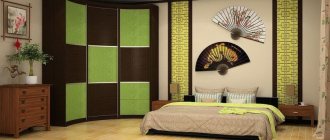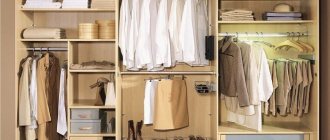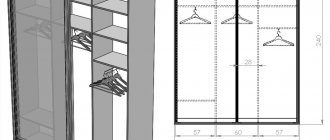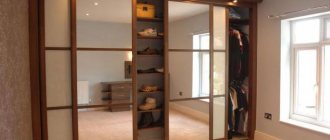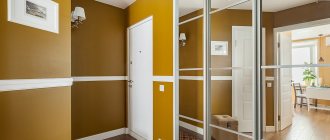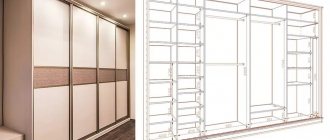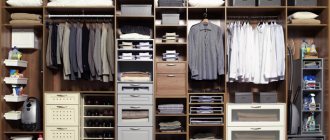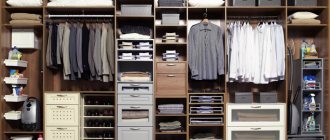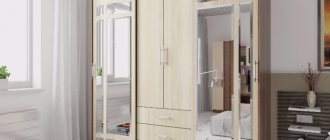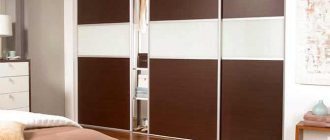Proper filling of the wardrobe and distribution of internal compartments guarantees the absence of inconvenience or discomfort during its operation. Depending on the location of the cabinet, the layout of the compartments may vary. So, nets with replaceable shoes in large quantities will become out of place in a closet located in a nursery. And retractable glove boxes are of little use in a closet located in the bedroom.
There are no specific standards and rules for internal filling, the number of shelves, the presence of mezzanines or drawers. The design of the interior space of the closet is filled depending on the number and type of clothing, as well as on the preferences of the owner of the room.
It is important to remember that the design of the internal layout of the filling of a wardrobe for any purpose must be based on clearly verified measurements.
Hand-made assembly according to your own drawings often contributes to the practical distribution of space. The owner always knows better than to fill an empty niche, whether to create an additional empty module for installing a television monitor, or to hide it with doors.
Depending on the location, there are several templates with easily redesigned modules. Some tips for planning the internal equipment of built-in wardrobes:
- the quantitative number of doors, as a rule, is equal to the number of compartments, with the exception of wide doors, behind which two sections can be placed;
- the wardrobe module with a bar is made wider than the compartment with shelves;
- the opening of the section for storing linen in height is no more than 40 cm, which is the most convenient option, while from 25 to 35 cm are allocated for books, depending on the printed publication;
- for the clothes compartment, the best option is to create two compartments - for short clothes, with a module height from the bottom partition to the bar of 100 cm, and for long clothes, with a module height of 160 cm;
- mezzanines intended for large items are made at least half a meter in height;
- the total depth of the cabinet, equipped with longitudinal rods, should be planned to be at least 65 cm, for a module with transverse rods - at least 50 cm due to the door mechanism;
- in the designs of drawers in which underwear will be stored, the dead zone must be taken into account - the frame of the compartment door mechanism, so that the drawers can slide out freely
- the depth of the drawers is designed taking into account the presence of hinged handles, if any, the height of the front panels of the drawer must be at least 25 cm;
- to pull out the drawers, it is advisable to use a ball-bearing mechanism that allows you to pull them out completely;
- shelves over 90 cm must be provided with a partition so that it does not sag;
- rods for hangers over 120 cm long must have a design with an additional rod resting on the floor with the lower end and tied to the upper shelf with the opposite end;
- to install baskets, shoe racks, trouser holders or tie holders, it is necessary to know their dimensions in advance in order to avoid falling into the internal parameters of the compartment intended for them;
- It is advisable to place the interior lighting of the cabinet, if this does not apply to the wardrobe, on the top panel, equipping it with 12 W halogen lamps;
- It is not advisable to make separate doors for a large mezzanine; it will fit perfectly behind the common doors;
- wardrobe compartments with rods should not be located in the outer compartments, since over time the outer modules, overloaded with things and not connected by shelves, may fall apart.
It is important to know that the content of built-in wardrobes depends on the intended purpose of the structure, which differ in the internal composition of the sections.
Filling the wardrobe in the bedroom
The predominance of large space in bedroom wardrobe designs determines the constant storage of bed linen and bedding. Clothes compartments, as a rule, are equipped with a pantograph - a retractable bar for hangers, equipped with a lowering device, and a standard version of the bar. The pantograph allows you to make maximum use of the upper volume of the clothing block of the closet.
Also, the filling of the wardrobe in the bedroom consists of the following blocks, compartments and modules:
- compartment where mesh baskets are attached;
- block with the inclusion of an end or conventional hanger;
- a panel equipped with hanging hooks for replaceable and wrinkle-free clothes;
- trouser hangers and tie holders with a retractable mechanism;
- pull-out multi-level drawers storing small items - cufflinks, belts, handkerchiefs;
- on one of the walls it is advisable to determine the place where the iron and folding ironing board will be hung;
- compartments for lower shoe blocks, as well as a compartment for slippers.
Filling principles
Despite the fact that there are no uniform standards when organizing the internal filling of a cabinet, before creating a project, experts recommend first of all taking into account three fundamental factors:
- location;
- individual preferences;
- available area.
As already mentioned, the specific features of the internal content of the structure are directly influenced by the location, since it is the purpose of the room that determines the nature of the things stored. For example, inside the wardrobe in the hallway there will be outerwear and shoes, in the bedroom - bed linen and household items, in the nursery - toys and school supplies.
It is worth paying attention to the personal preferences of users: having a hobby (drawing, sewing...), specific items in the wardrobe, a large amount of cosmetics, jewelry, a collection of watches, belts, ties and other accessories requires the creation of separate functional areas and the introduction of appropriate elements into the design.
Free area is another important parameter, since it directly affects the size of the body and the main structural characteristics of the structure, which in turn determines the possibility/impossibility of using some functional elements. For example, with a cabinet depth of 300 mm, taking into account the thickness of the sliding system, the useful depth will be slightly more than 200 mm, which makes the installation of longitudinal rods pointless.
Filling the wardrobe in the hallway
The specificity of some hallway cabinet designs lies in their non-standard dimensions. The optimal width of built-in furniture of this plan corresponds to only 0.4 meters with standard parameters of 0.6 m. For such narrow wardrobes, it is possible to install transverse rods for hanging hangers.
The correct design for filling such a closet will allow you to place the maximum number of things in the closet. It is very important to have a modular unit in the hallway that allows you to store seasonal clothes, as well as a separate dimensional section in the lower location of the shoe closet.
We should not forget that excessive loading of a wardrobe in the hallway with irrational design of sections leads to a loss of functionality of the object.
Functional elements
They also differ depending on the room.
A built-in wardrobe in the hallway, unlike a bedroom, may not have a compartment for an ironing board, for example.
But in general terms they are similar:
- Mezzanine. The upper part, where various minor things are often stored. As a rule, these are seasonal clothes that are needed only in winter. Often spare sets of bed linen are put there. As a rule, dust accumulates there least often.
- Ironing section. Typically, this is a tall and narrow compartment into which the board is installed. Often it comes with a closet. It covers a small area behind which you can store an iron or steamer. By the way, there are options in the form of a small travel box. There is a mini ironer installed there, which is quite suitable for small items, like T-shirts or shirts.
- Department for outerwear. As a rule, it is a transverse rod on which hangers are hung. It takes up a lot of space and, depending on the room, can have different lengths. In hallways, for example, it can occupy the entire width of the cabinet.
You can see photos with the correct organization of space below.
Filling the wardrobe in the nursery
To ensure the safety of the child and teach him order, the filling of the wardrobe in the nursery is selected in the most careful way.
The upper zone is temporarily reserved for the needs of adults. The lower compartments are designed in such a way that the child has access to his personal belongings. The modules are created in such a way that as the child grows older, he can independently use the entire closet.
Lifting and sliding mechanisms are selected from simple but reliable systems that cannot be disassembled by children. There should be no discomfort in using retractable drawers for a small person, so that the child can freely pull them out many times, without fear that any of the mechanisms will break.
Sliding wardrobe 3 meters wide internal filling. What departments should there be? Cabinet and built-in wardrobe: similarities and differences.
Filling the wardrobe photo of the internal layout
Built-in furniture is created for a comfortable existence and rational use of the entire area of the room. The main criterion for planning the filling of a wardrobe is its location in the home. We present a series of photos of the internal layout and design of cabinets for various purposes.
A variety of three- and two-door wardrobes for hallways:
Dressing room alternative:
corner wardrobe:
and a five-door wardrobe
Sliding wardrobe for the children's room from Baltic designers:
A wardrobe in the hallway is one of the most necessary pieces of furniture. What should a proper closet look like inside? You need to consider who and what things you will need a closet for. For some, shoe shelves and a couple of hangers will be enough, while others plan to store bedding, bags and even a washing machine there.
Here, for example, everything is arranged not only rationally, but also with the use of unusual shelves, for example, a dynamic shelf in which every little thing can be conveniently reached.
Proper filling of the wardrobe
There are no specific rules. The main thing is to think through everything in advance and draw a sketch. You can even make a cabinet yourself using ready-made drawings. It is important to consider the size of your hallway.
For a small family or even one person, a single-door wardrobe is suitable. But the number of sections is at least two. The cabinet should be divided into sections. It is convenient to leave shoes or even sports equipment here; such a closet resembles a small room, but it takes up little space.
For your convenience, the interior of the closet in the hallway should contain hangers, shelves for shoes, drawers for gloves, hats, mittens, possibly stands for hats and umbrellas. If the hallway is spacious enough, a sliding wardrobe can replace an entire dressing room with a mirror and space for changing clothes.
The width of the shelves is at least 80-90 cm, but there is also an option for narrow shelves (40 cm) if there is no space at all in the hallway.
For outerwear: coats, raincoats, fur coats, the height of the closet should not be less than 140 cm. It is most practical to place the crossbar (it serves as a hanger holder) not deep into the closet, but across it.
This closet not only has convenient shelves for clothes and accessories, but also a decorative corner shelf for small items.
Practical wardrobe inside - features
There are much more filling options for two-door and three-door cabinets than for one-door cabinets. Items designed for storage may include bedding, seasonal clothing, tablecloths, towels, magazines, and even built-in sections for jewelry and beauty supplies.
Metal cabinets are very convenient; dirt and debris do not accumulate in them, and they are also very light, which is important for complex structures.
The width of the shelves varies from forty centimeters and more.
The arrangement of things in the closet can be done according to a very convenient scheme:
- In the middle are frequently worn items so that they are always at eye level.
- On top are rare and unnecessary items, such as hats or carnival costumes.
- The most bulky and heaviest things, such as suitcases, are stored at the bottom.
Storage system zoning
Regardless of the configuration, any product inside is divided into conventional horizontal zones. As a rule, there are three of them.
- The lower zone is a compartment located below eye level and arm's length. Usually reserved for placing shoes, bed linen (in the bedroom or nursery), suitcases, bags or sports equipment. Here you can store any heavy items whose weight cannot be supported by the upper tier. Placing standard shelves for things in this area is not very convenient, because you will have to constantly bend over to get them, so drawers and pull-out baskets are suitable for filling.
- The middle one is the main part of any closet. This includes everything that is at eye level and that is easy to reach. Therefore, in the middle part there are hangers, shelves and hanging organizers for clothes and linen, which are used constantly. They should always be easy to access and this area should be well lit.
- Upper - the remaining space at the top is allocated for mezzanine shelves, which may not be as easy to reach as things in the middle zone. Most often, this part is used to place seasonal clothing, spare sets of underwear, hats and everything that is rarely worn and, therefore, taken out.
Instagram @design_studio13
Instagram @bodes_studio
Unsplash
Instagram @jo.marie_b
- Storage systems
How to properly plan a closet from IKEA and more: 6 steps
What cabinet filling should I choose?
A corner closet occupies a non-standard hallway area. A corner closet is a mini-wardrobe; a lot of things, especially non-standard sizes, fit in the occupied space.
A straight cabinet holds less space, but it is easier to fit into the overall interior of the hallway.
Make sure that the closet does not interfere with the passage to other rooms. The hallway should be comfortable and spacious. The internal elements are made of a metal frame to make it stronger and more reliable. Check that the doors move smoothly and without jerking.
You can put boxes in large cabinets, like in this photo, then the cabinet will look neater.
Such a cabinet is sometimes inconvenient due to its narrow code and rather voluminous structure.
Pay attention to whether the lighting is located here; sometimes there is not enough light in the hallway to find something or choose an image.
To store men's belts and ties, special pull-out holders or shelves with cells are used as the internal filling of the cabinet, which are attached to the sides and are very convenient to use. Shoe boxes (nets) are practical, but they should not be located close to the floor (dirt accumulates under them and is inconvenient to clean). The width of the mesh can vary from 30 cm (for a pair of shoes) to 100 cm or more.
Built-in wardrobes in the hallway are quite convenient. The top bar goes under the ceiling. There is no free space left on the sides either. Thus, the entire area is used to the maximum.
It is not very convenient to place the crossbar deep into it; there is not enough room for outerwear. But then the closet may not be very deep.
A very rational idea to put a washing machine in the hallway closet. Often in small apartments this is the only place where it will fit..
And here the ironing board is also included.
There are suitcases on top here, although here you need to be sure that they are not very heavy.
Wooden and pull-out shoe shelves are not always practical, because they often get dirty and sand accumulates there.
It is very convenient to store shoes in the pull-out metal shelves, so they will also dry properly.
In any case, we must remember that the wardrobe is designed for more than one year. Therefore, the design of the internal space must take into account the perspective and maximum filling, as well as the features of the hallway in which it will stand.
In the latter option, both closed cabinets and open hangers are very conveniently located where you can hang casual clothes.
Proper space planning requires a great deal of experience. In this article we tried to draw your attention to the main points of the correct layout of a wardrobe.
It is better to make the total depth of the wardrobe at least 65 cm, since 10 cm will be spent on installing the door mechanism.
For short items, use 2 parallel rods on top of each other, so you can fit more clothes.
Make drawers and baskets at a height of no higher than 120 cm, otherwise they will become inconvenient to use later.
Based on practice, the optimal distance between shelves is 35-40 cm.
It is better to hang the barbell at a height of 170-190cm from the floor; if you hang it higher, it will be inconvenient to reach; hang it lower - you will not be using the space optimally.
If you place 2 rods under short clothes one above the other, as we advised above, then the most optimal distance between them will be 80-100 cm.
Ideally, you need to measure the length of the clothing and add about 20 cm to it (then the total height of the hangers themselves will be taken into account with the distance from the top shelf to the bar itself.
Accessories for sliding wardrobes (shelves for shoes, hangers for ties) always fit few things, and they are not cheap.
- To store shoes, it is better to use regular shelves on which shoes can be placed in 2 rows or in boxes.
- Since large items are usually placed on the mezzanine, its opening height should be 45-50 centimeters.
- Provide drawers for storing underwear .
- The height of the front panel of the drawer is 20-25 cm, but remember that the height of the drawer box is 3-5 cm less than the front panel, this depends on the type of guides.
- It is better to use full extension guides, because it is convenient when the inside of the drawer extends completely.
- And also, never make empty openings with rods in the outer compartments of the cabinet , because the side panel may simply fall off if the door hits you. Shelves will solve this problem - they will connect the side panel of the cabinet with the entire structure.
It is worth saying that in each situation everything is individual: only you can decide what your wardrobe will look like inside, how much space can be used for a wardrobe, how many shelves and what to make it for, but be sure to consult with a specialist.
Rules for internal content
Naturally, the contents of cabinets and dressing rooms depend on their location. The reason is that you should not throw things from different rooms into the same furniture. The easiest way is to take our cheat sheet, which will be convenient for organization.
Hallway
Often it will not be possible to place other furniture in the hallway. You need to fit a lot of things there, and regular hangers will be extremely inconvenient. It just needs to be related to the size of the hallway. The technology of the coupe allows for a real increase in comfort.
In general, it is enough to know a few rules:
- The internal filling of a sliding wardrobe is impossible without special modules and sections. They may already be built-in. Many models are already sold with such an organization. Therefore, it is recommended to buy custom-made furniture for the hallway.
- The upper tier is given over to seasonal items that are no longer relevant. You can put winter jackets and boots there in summer. This is quite convenient, since they will not interfere the rest of the time. It is more convenient if clothes are stored in boxes or special drawers.
- The middle tier is a great place for outerwear. As a rule, there is a stretched metal or wire rod on which hangers are attached. In winter it is convenient to place jackets and coats there, and in summer - shirts and windbreakers. This way they won't wrinkle. Also, all things will be visible and you won’t have to look for them. It will be easier to fill the inside of your closet if each individual shirt or jacket is on a separate tray.
- The lower tier is reserved for shoes. It is best to put a mesh plastic basket. When it rains, the water will drain and not stagnate. By the way, it can be supplemented with a special tray for collecting water.
In the case of placement in the hallway, a mirrored door is required.
Bedroom
This room is needed for relaxation, but it is often cluttered. Because of this, she becomes uncomfortable. They buy cabinets of this type specifically for this purpose. It will help with organization and prevent the resting place from becoming cluttered.
The contents of the wardrobes here are as follows:
- The upper tier is given over to not the most important things that are needed right now. For example, these could be pillows, blankets, sheets and pillowcases. This is also a great place for bags and soft toys.
- In the main part you can store both street and home clothes. Unlike the wardrobe in the hallway, the bedroom is much smaller. Therefore, it is better not to mix them. There is usually a short barbell here. Also on this tier there are special drawers and flat horizontal surfaces where you can store things folded. In addition, there is space for ties, bow ties, and clothing accessories. There are models with a folding ironing board.
- The lower tier contains bulky equipment and boxes. As a rule, there is enough space there, so a vacuum cleaner, iron, or steam generator can be left here.
The filling of the wardrobe in the bedroom should be zonal.
It is better not to store things here that do not directly relate to this room.
Children's
Designing closets for a child is not much different from an adult bedroom. Here the wardrobe must perform several functions at once. This furniture alone is enough to fit toys, clothes and even shoes in one place. In general, in addition to the compartment, you can only put a bed and a desk, and this is enough for functional furniture.
Before you design a cabinet, it's worth keeping its purpose in mind. It is not bought for one year, but the child will grow, his preferences will change and he will need other clothes, toys, and hobby items.
The top floor will not be accessible to the child, especially if the closet is under the ceiling. You can safely put bedding and seasonal clothes there. In other matters, you can make a temporary warehouse there for things that the child has already outgrown.
In addition, the top is an excellent pantry where it is easy to store non-essential items.
How to properly plan furniture in a nursery? It is impossible not to take into account that the middle part must be firmly secured. A child can climb in there and risk being overwhelmed by things. Therefore, you need to take care of strong hangers. In principle, a pantograph is appropriate. In furniture production this is what they call a retractable bar. The child will not be able to reach it, but parents will be able to pull out the pantograph at any time.
The bottom is suitable for items of first availability. For example, underwear, pajamas. If there is a lot of space left there, why not store toys there? The bottom tier is enough to fit all the plush joys of a child inside, and there will also be room for bedding.
How to order a wardrobe
Take advantage of a free consultation with our specialist. A home visit and individual closet planning are provided. You can also place an order right on the spot.
Specialist consultation
Ordering a wardrobe is only half the battle. And the second half of the battle. And the first and most important thing is to plan what the inside of the wardrobe will look like. Correctly defined needs will bring satisfaction in the future when using the cabinet.
The structure of the sliding wardrobe consists of:
- shelves;
- drawers;
- rod;
- mesh baskets;
This is the minimum required set that should be in any self-respecting closet. Now a little more detail.
Additional items
The internal structure of the wardrobe can be supplemented with elements such as a trouser holder or a tie holder. For those who like to wear a suit, it is very important that the trousers are not wrinkled. A trouser will help save the situation.
But you can quickly choose a tie using a tie maker. The entire stock of tie models you have will be presented to your attention. Some manufacturers offer tie makers with special lighting. To make it easier to decide whether this tie matches your shirt and jacket.
There is also a separate hanger for belts. If this is not available, the belts can be stored rolled up.
If the depth of the closet is shallow, a cross hanger is suitable for placing a large number of things. Clothes will be placed parallel to the wall, which will save space.
Also, the inside of the closet can become a refuge for many, many more items. For example, with the help of a special mount, a vacuum cleaner hose will fit perfectly here.
To make the most of the internal structure of the wardrobe, do not rush to choose the standard option. Think for yourself, consult with a designer, apply non-standard solutions. And then the whole world will fit inside your closet. The world of your favorite things.
Happy device!
Optimal layout and rational use of space is the key to comfort. The placement of furniture in the room is a key factor.
Thanks to individual design, a wardrobe can be organically “fitted” into areas previously considered oversized.
But just buying a cabinet is not enough. It needs to serve not just as “furniture”, but to become a functional item and help organize the necessary things. To do this, you need to know how to plan a closet inside.
You can easily arrange things of different lengths in it, and numerous shelves will help you freely place other small items.
First you need to decide on the location of the cabinet. It is this fact that will decide how it will look in the end: its depth, height, width, content.
Be careful when choosing a door extension mechanism - it should not be too noisy.
For a more specific representation of the location of the furniture, you can limit the place that is intended for installation to the available items. This way you can evaluate the space occupied in the room and adjust the dimensions of future furniture.
The sliding wardrobe will fit into most modern styles.
If you take an overview of all the components of the wardrobe, you can identify the main components:
- Base (lower base);
- System (base or “support”, this includes sliding devices - wheels, rails);
- Furniture panels (walls, ceiling, floor);
- Doors (may have different types, operating principle – sliding);
- False panel (located in the part where it is better to hide the voids);
- Frame or rod (located parallel to the door, or perpendicular, trempels are hung on them).
If you take an overview of all the components of the wardrobe, you can identify the main components:
Regarding the internal contents, the components here are known to everyone - drawers, shelves, compartments. They can be combined and achieve the desired results.
For example, if you are choosing a wardrobe for a bedroom, then there are some classic components that are present in almost every option:
- Shelves. Their number can vary depending on needs and can be located in any part of it;
This also applies to the distance between them.
— Drawers. Usually located at the bottom, depending on the purpose they have different depths and quantities;
Drawers are usually used as a chest of drawers.
- Barbells. For large sizes, one or more rods can be installed, which are used for hanging clothes.
The bar can be for short clothes (blouses, jackets, skirts) and for long ones (coats, raincoats, dresses).
If the filling of the cabinet is planned for the hallway and dressing room, then the composition will not be radically different. The only thing that may vary is the number of component elements depending on the purpose of the wardrobe. The lack of rods or drawers is likely compensated by the presence of plenty of shelves and storage compartments.
A variety of “fillings” can be chosen based on personal needs.
When choosing the location of the elements, you should also think about which family members will use them. For example, if a child is given personal space for clothes and things, then it should be placed in a place accessible for his growth. The compartment for this can be laid out like this: at the bottom there is a retractable drawer, a shelf and a rod for trempels. When planning a space for adults' belongings, consider whether there will be storage for items other than clothing (blankets, sheets, pillows, shoe boxes, etc.).
This will make the necessary layout of the wardrobe clear.
What sizes to choose
To determine the dimensions and choose the optimal filling of the cabinet, it is better to immediately take into account the factors that will become decisive in the choice.
1. Depth
If we talk about sizes, then everything is purely individual. But there are also standards that are often used. It's about depth. As a rule, it is 60 cm.
If we take into account the door system, it increases by another 5 cm.
But what if this option is not suitable? There is custom-made furniture to satisfy all customer needs in terms of depth, width, height of the product and even the design on the doors. If desired, you can order a structure with a depth of 40 cm and it will optimally “fit” into the interior.
For example, it is suitable for a corridor in which outerwear is hung and shoes are stored.
2. Height
The layout of the wardrobe inside and its dimensions should be adjusted as much as possible for all household members. It is worth taking into account, first of all, height and the ability to use a ladder or chair in order to reach the highest point.
Rarely used and seasonal items, bags and suitcases, and boxes of shoes are stored upstairs.
Usually, even hard-to-reach places are occupied by things that are rarely used in everyday life. For practicality reasons, many people purchase a ceiling-mounted cabinet.
In this case, you will not need to constantly shake off the settled dust.
3. Width
According to this criterion, there cannot be any rules, because the width is chosen purely on the characteristics of the room, the number of things it can accommodate, where it will be located and the wishes of the homeowners.
The wider the furniture, the greater the number of sections that can be there.
Putting a closet in a corner, if the space of the room dictates it, is not difficult. You only need to know the width of one and the second part. If the shape resembles the letter “P”, then, knowing the width of all parts, you can create a well-planned structure.
The number and width of sliding doors will depend on this.
Don't overestimate your capabilities in terms of size. If there is no need for a large wardrobe and there are no plans to purchase a large number of things, then you should buy a more modest-sized piece of furniture.
It is advisable to place small wardrobes in small hallways - standard products simply will not fit there, blocking the passage.
And vice versa - for a large volume of things, they initially consider purchasing a large-sized version so that everything fits and finds its place.
It is quite possible to place a large wardrobe in a spacious living room or bedroom.
Sliding wardrobe: how to plan correctly
For structures that will be located in different parts of the room, it is necessary to select its own individual internal component. Let's take a closer look at the basic configurations that are offered for different indoor locations.
1. Bedroom
Although the supposed presence of elements has already been described above, it would be useful to clarify many things.
Thanks to properly selected contents, such a closet can accommodate almost your entire wardrobe.
The usual contents of a bedroom closet must meet the following requirements:
- Availability of space for folding bedding (shelves);
- Storage of underwear (drawers with divisions);
- Hanging clothes for everyday use (a rod with trempels, where it can be in two levels for clothes of different lengths);
- Storage of accessories (drawers with divisions or shelves);
- Household “needs” (ironing board, iron, steamer, hair clipper and much more will fit in the compartments between departments or in a special place designated for this).
It can easily fit not only your things, but also bed linen, additional sets of pillows and blankets, and even an ironing board.
2. Hallway
Since hallways in different houses and apartments have different shapes, widths and lengths, you need to select furniture according to these features. The wardrobe system has a sliding door type, it will suit almost any type of hallway.
Here it’s worth starting from the depth of the closet.
The hallway needs space for the following things:
- Outerwear (barbell);
- Shoes (shelves, retractable systems with storage spaces);
- Accessories (shelves, drawers);
It would be appropriate to place a mirror on one or two doors.
A wardrobe in the hallway is indispensable for storing clothes for each season and numerous shoes.
3. Dressing room
How to plan a wardrobe inside for a dressing room? There is more room for imagination here, because you can place anything you want in the dressing room and in the quantities that the dimensions allow.
Thoughtful organization of space and storage of things will undoubtedly play into your hands.
You can place in the compartment:
- All types of clothing, from underwear to fur coats or jackets (retractable structures with divisions and rods are used);
- All kinds of accessories from earrings to travel bags and suitcases (pull-out top shelves about 50 cm wide);
- Shoes (racks and holders);
- Hats (shelves);
- Household items (shelves, retractable systems).
The number of shelves, sections and furniture dimensions depend on the volume of internal space.
Rules for internal filling depending on location
Depending on the location of the wardrobe, the design of the internal filling will differ significantly from room to room, therefore, in order not to “reinvent the wheel” from scratch each time, there are certain rules that take into account these features, and on which, subsequently, it is necessary to apply individual schemes placing things.
For the hallway
For a hallway, a wardrobe is the most successful solution when organizing a storage system, since the sliding door mechanism provides free passage in a limited opening, and if there is a niche, you can create a full-fledged dressing room.
The internal filling of the closet must necessarily contain modules for storing outerwear, shoes and accessories. If possible, open corner shelves are additionally installed for various small items.
The upper part of the structure is reserved for storing rarely used and seasonal items, shoe boxes, suitcases, travel bags, etc.
In the middle part, at an accessible height, longitudinal and transverse rods for hangers are installed; in high structures, a pantograph is mounted, which allows you to easily lower the top rows of clothes. If necessary, holders for umbrellas, hats, and keys are added.
Closer to the floor, wire mesh baskets are installed for storing shoes, shelves for care products, and space is allocated for household appliances and tools.
It is important to note that it is recommended to use a mirror as a sliding door leaf, as it allows you to evaluate your appearance and quickly correct any deficiencies found.
For the bedroom
The bedroom is the most important room for every person, as it is a place of privacy, relaxation and sleep. At the same time, this room is a “storage room” for a large amount of clothing and various accessories that are not desirable to be put on public display. Therefore, in order not to clutter up the existing space, as well as to get rid of existing visual and physical trash, it is necessary to properly plan the storage system.
A spacious wardrobe for the bedroom is a real godsend, as it allows you to distribute all the available things in their own corners and free up your living space as much as possible.
The upper section of the closet should be used to place bedding - pillows, blankets, blankets, spare sets. There are also old bags, boxes with personal belongings, formal shoes that are worn for special occasions no more than a couple of times a year, and other rarely used items.
In the main part, casual clothes, pajamas, bathrobes, and towels should be stored on the shelves. Underwear and underwear are stored in drawers, separately for men and women. Delicate items - shirts, pants, skirts, dresses - are placed on hangers. You can place accessories, ties, watches, and documents in separate compartment sections. If necessary, the design can also be equipped with a folding or retractable ironing board.
The lower part is usually used to store the most bulky items - household appliances, boxes with mixed contents, hobby supplies.
For children's
A children's room is a multifunctional room that combines a bedroom, an office, and a playroom. A child’s room should not only have a special color and atmosphere of joy, but also provide space for active recreation, study and creativity, as well as ensure safety in all its manifestations, including when using furniture.
Since a wardrobe is purchased for more than one year, the design of the internal contents must be developed carefully, taking into account the age and gender of the child, subsequent growing up, and certain interests and hobbies. It is also important to hear his own suggestions in this regard.
The upper part of the structure will most likely be inaccessible to the child, so bedding, seasonal clothing, items for themed events and other items that are not useful in everyday activities should be placed in it.
When using the main section, the child should not make any effort to get the necessary item, otherwise there is an increased likelihood of injury - all items must be within reach. In this situation, it is most important to use a pantograph for easy access to high longitudinal rods on which jackets, shirts, trousers, and skirts will be stored.
Shelves below eye level can be used to store knitwear and underwear, while shelves higher can be used for hats and outdoor accessories. There must be a compartment for toys and creative supplies; a separate section can be allocated for fiction, textbooks, notebooks and stationery.
The lower tier is necessary for storing clean indoor and outdoor shoes, sports equipment, and large toys.
It is also important to take into account the manufacturing features of the structure - all corners must be edged with PVC edges, and the glass must be made using triplex technology or covered with a protective film to prevent the appearance of splinters. However, despite the complex of protective measures, experts still recommend abandoning the use of pull-out shelves in favor of baskets and plastic boxes when there are preschool children.
Installation
All components are manufactured both according to standard design and to order. The first option may immediately fit into the right place, or it may require an individual approach. Then the wardrobe will be made based on the client’s wishes.
As a façade decor, it is better to choose a mirror surface for at least one of the doors.
After using the wardrobe for some time, the layout inside may not meet the comfort standards of an individual family. Then you can modernize the existing filling of the cabinet by adding or removing some elements. To carry out installation, it is enough to have the necessary fittings and a screwdriver. In extreme cases, you can call a specialist.
For installation, special fittings are used - for elements that can be pulled out, doors, rod mounts, lighting, etc.
